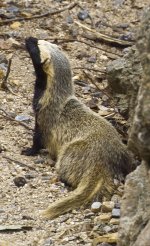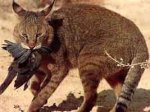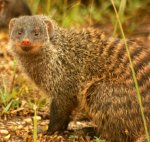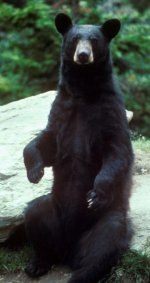Sunday 29 July 2007
Lesser Grison

The body of the
Lesser Grison (
Galictis cuja) and the neck are long, and it has a narrow chest, short tail, short legs and the head is small too. Furthermore, its ears are rounded and also small. Salt and pepper would be the best description for the head's top and the tail. Its belly, throat and legs are pure black but every once in a while, grizzled. A Lesser Grison's fur is basically coarse, but the undercoat is short and soft. The toes are webbed in character, claws look menacing enough, being sharp and curved. Lesser Grisons have heels that are hairy, but the soles are bare.
The Lesser Grison is found in Bolivia, Peru, central Chile, Uruguay, Paraguay, Argentina and Brazil. At Peru, the Lesser Grison stays in high altitudes while in Paraguay, they could be seen in moisture-deprived grounds. Still, these grisons are able to live in a wide number of habitats, and some of these are: brushy territories below timberline, semideciduous montane forests, evergreen lands, steppes, open woodlands, chaco desert, arid srub areas, and even seashore grounds.
The Lesser grison is categorized as monogamous, pairs hunt during times where the young are being reared. The litter size ranges from 2 to 5, and the young are capable of leaving the birth place just after a few days. The Lesser Grison is recognized for its aggressiveness, fact is, there is a Chilean expression which says: "estar como quique", translated as: be like a grison. According to one recorded event, a grison met three dogs (this was in Uruguay) and it was able to hold its own, meaning to say, it must have survived, maybe even killing all three. Here is another amusing incident, a guinea pig was traversing uphill, hidden by tall grass, a grison was moving too (uphill) in a random fashion. Its movement carried it to meet the pig's direction head-on, and it was obvious that neither had been aware of the other's presence. They collided, and the shocked pig fled, while the grison was left behind.
They are active in daytime, but they also go for prey during dusk hours.
Female grison would play with a living prey (ie. grasshoppers) after the capture. It would play with it for 4 to 45 minutes.
Image of the Lesser Grison by Ken Erickson, licensed under
GFDL
You can help spreading the word about this animal by liking it on facebook
Permanent Link
Tuesday 24 July 2007
Jungle cat

The population of
Jungle cats (
Felis chaus) is significant in India (and adjacent nations), but is recognized by just a singular historical specimen from Vietnam or Cambodia. At Indochina, all the other small/medium cats are noted more often than the Jungle Cats. Habitat survival (read: adapting) in other areas would allow a better conservation status if man's hunting could be cut down considerably. Sadly, they are frequently killed by man, and maybe we could not blame them (the humans)...these cats have been known to kill livestock too.
The Jungle Cat is active during the day, and they have a shelter to take refuge in if a rest is needed. Breeding season for the Jungle Cat depends on the range actually. At the north parts, they mate during the winter da
ys, but if they are in the south areas, they could mate at any time within the year. When gestating is through (2 months), one to six kittens come out. When the newborn reaches 8 weeks old, they are weaned, and at about
6 months old, they could be segregated from the female parent. These cats are solitary by nature, and when resting, one would twist the forefeet and put them under its body.
Let us go to the Jungle Cat's food habits, they eat small mammals, hares, snakes, birds, frogs and lizards. Eating or not, they are often located near water, and the moist territories give them the best habitat cover of
grasslands and reeds. (These are useful to them in the way of
camouflage.) It may fascinate you to know that present-day scientists think and hypothesize that domestic cats hold similar genetic links to this kind of cat, but that could not be proven yet beyond a shadow of a doubt.
In the mating season, a male would bark, in a dog-like fashion.
You can help spreading the word about this animal by liking it on facebook
Permanent Link
Sunday 22 July 2007
Banded mongoose

A
Banded Mongoose (
Mungos mungo) lives in parts of Africa, and its main distribution is at the Sahara's south parts. Outside this main distribution, it could be located from Gambia to Ethiopia. Banded mongooses could survive on many habitats, such as rocky ground, woods and grasslands. One habitat they could not survive on however, are the deserts.
It is basically considered as small, in the breeds of mongoose. A Banded Mongoose could be recognized apart from its relatives by the set of black marks along the back, midback and tail's area. Their cheek teeth have rounded cusps, and a Banded Mongoose's muzzle is quite pointed. Just like us, it has 5 digits on the foot (front) but at the hind foot, it has four (unlike us). These hind feet have claws.
The litter size varies, anything from 2 to 6, and these young come into the world via grassy chambers, which are holes on the soil, or even termite homes. A young would be fed by a lactating female, not necessarily the m
other. If the pack leaves for preying adventures, on the average, a female for 8 newborns would be left behind. The newborns would start leaving the nesting ground at around a month old.
A Banded Mongoose is diurnal, and definitely not a solitary creature. They exist in packs that number from ten to twenty. However, when hunting, there are times when an individual would be a loner. As per past observations, it has been shown that they help each other when the prey is a dangerous one, like a sand snake. What about aggression within the males within the same pack? Very little actually, any quarrel over food is conceded to the dominant male. If the pack is under threat, they would all scatter in any and all directions, if escape is going to be an easy one for them. Now it gets interesting, if escape is NOT easy for them, they would get close to each other, encircling the young ones.
The reproduction within a group is usually synchronized, and as a result, many females would give birth WITHIN the same week, just few days apart.
* Author: TKnoxB]
*
Source
* Licensed under
Creative Commons Attribution 2.0 License
You can help spreading the word about this animal by liking it on facebook
Permanent Link
Friday 20 July 2007
American Black Bear

The
American Black Bear (
Ursus americanus) exists in various places: Canada, from Atlantic to Pacific, and 40 states of the US. There were probably around 2 million of these bears prior to European colonization, but their numbers drastically went down to 200,000, coming from the destruction of their habitat.
The female American Black Bear weighs from 40 to 180 kg, while the males from 114 all the way to 274 kgs. Those are the norm, but it has been known that a male could go up to 365kgs, but that would be a very rare occurrence. Adult American Black Bears have round ears, small eyes and a long snout. Usually, they would have shaggy covering, but the color would differ: there are brown, black and even blonde. They could stand/walk using the hind legs, but usually, they move on all fours. The shuffling walk we are so familiar with comes from the fact that the hind legs are a bit longer than the front ones.
The typical American Black Bear of Canada opts to stay in forested areas, wet hardwood and forests (conifer kind). They sometimes go through hibernation in winter and to take refuge, would build their homes in tree holes, banks, and even under logs. For the mountain areas, they would opt for lower elevations in the search for food, and they would relocate to northerly slopes (higher ground) when summer sets in. These bears actually climb the trees if under threat, and they use the forest as travel paths.
The mating is usually done in summer, June to middle of August, with some variations in some cases. Cubs are tiny, born hairless and blind. The average is 2-3 cubs for a birth, but a number of five is not impossible. In times where a parent (female) senses any kind of threat, she would grunt as a warning to the cubs, and they would then climb up (a tree)...actually, the survival of the young depends on the parent's skills in teaching. Teaching in terms of eating, where to take refuge, and when to anticipate dangers.
The concept that these bears are inclined to kill/harm humans without provocation is probably a gross exaggeration. Estimate-wise, there have been ONLY fifty-six cases of humans (being killed) in North America, for the past century.
You can help spreading the word about this animal by liking it on facebook
Permanent Link
Sunday 01 July 2007
Weddell Seal

The
Weddell Seal (Leptonychotes weddellii) could be found scattered all over the Antartic but also on (at least) 15 islands nearby. They are arctic region dwellers, both on fast ice and on sea, migrating is something they do not do, and being shifted from one place to another are caused by ice conditions/movements. Swimming underwater happens when the ice areas are thin so that the Weddell Seal could punch holes (by their teeth that is). From November up to the Yuletide season, the females become pregnant.
They give birth on sea ice. Weddell Seal newborns weigh around 30 kg upon birth, but that is on the average. Six weeks of age is the time for weaning, and here is one trivia for you. The male Weddell Seal do not usually mate until six to seven years old. This particular seal navigates in slow motion (humping motion that is) both on ground and on ice. This you do not (chances are): the Weddell Seal could swim at a clip of 5 to 7 knots. The depths they can reach could go up to 600 meters, and it could remain submerged for 60 minutes. They also eat underwater.
Weddell Seals are are killed for dog-food purposes that have seal as an ingredient. One last thing, in case you are wondering about the name, they were named after James Weddell, the top man of a sealing expedition.
Interesting fact: Studies done by scholars/experts on the vocal ability of these seal have helped in mankind's attempts in the field of communications with animals.
You can help spreading the word about this animal by liking it on facebook
Permanent Link
 The body of the Lesser Grison (Galictis cuja) and the neck are long, and it has a narrow chest, short tail, short legs and the head is small too. Furthermore, its ears are rounded and also small. Salt and pepper would be the best description for the head's top and the tail. Its belly, throat and legs are pure black but every once in a while, grizzled. A Lesser Grison's fur is basically coarse, but the undercoat is short and soft. The toes are webbed in character, claws look menacing enough, being sharp and curved. Lesser Grisons have heels that are hairy, but the soles are bare.
The body of the Lesser Grison (Galictis cuja) and the neck are long, and it has a narrow chest, short tail, short legs and the head is small too. Furthermore, its ears are rounded and also small. Salt and pepper would be the best description for the head's top and the tail. Its belly, throat and legs are pure black but every once in a while, grizzled. A Lesser Grison's fur is basically coarse, but the undercoat is short and soft. The toes are webbed in character, claws look menacing enough, being sharp and curved. Lesser Grisons have heels that are hairy, but the soles are bare. 
 The population of
The population of  A
A  The
The  The
The